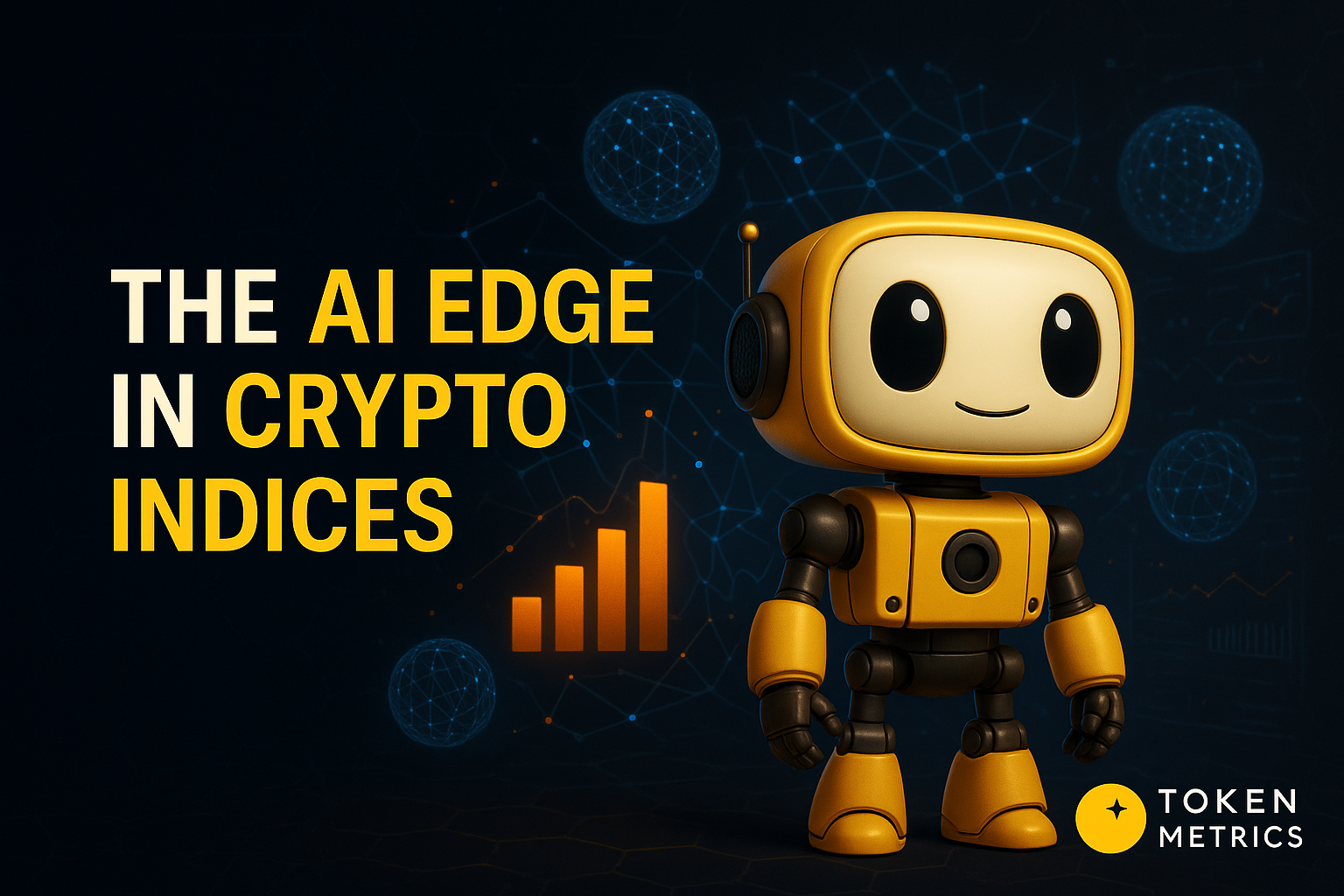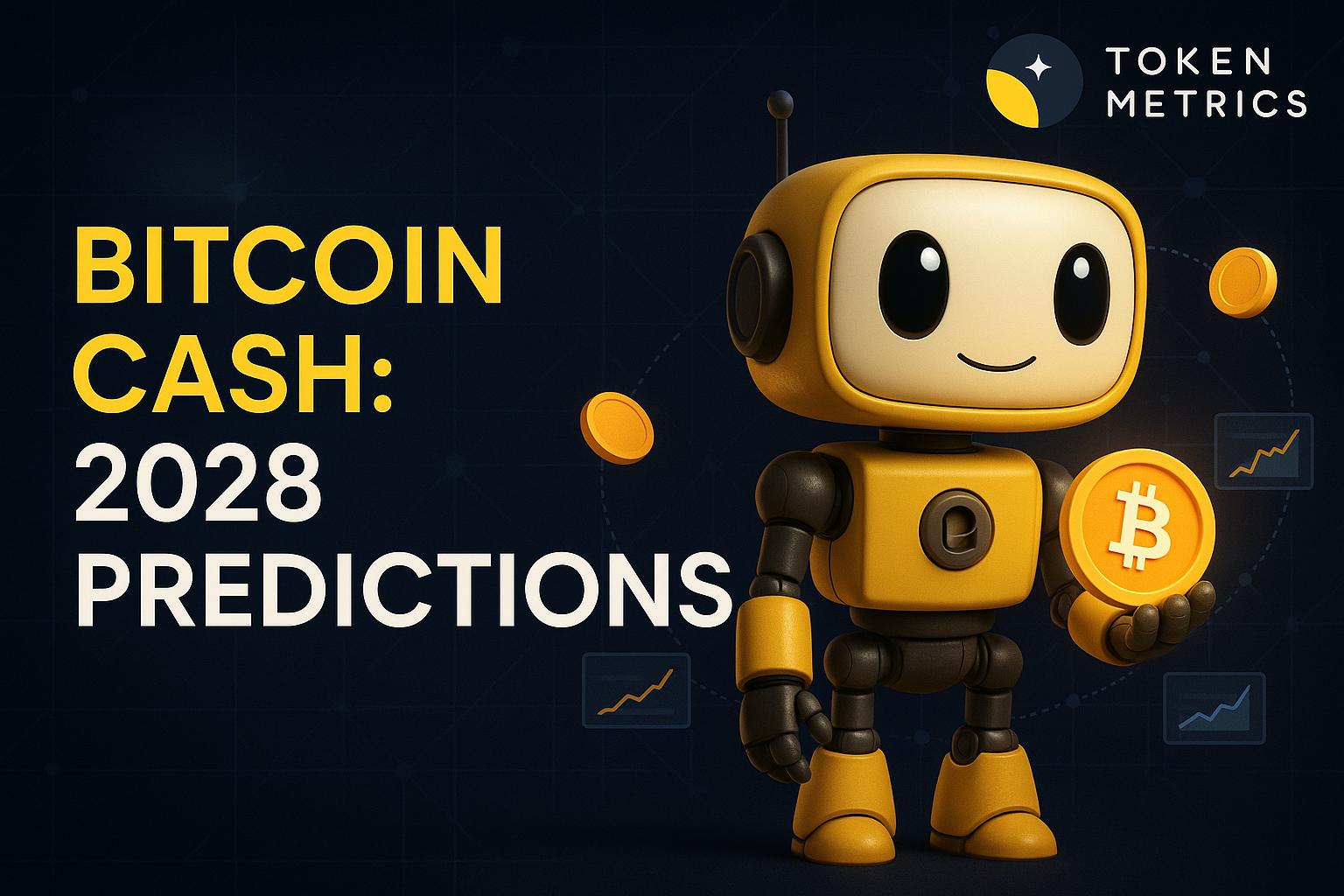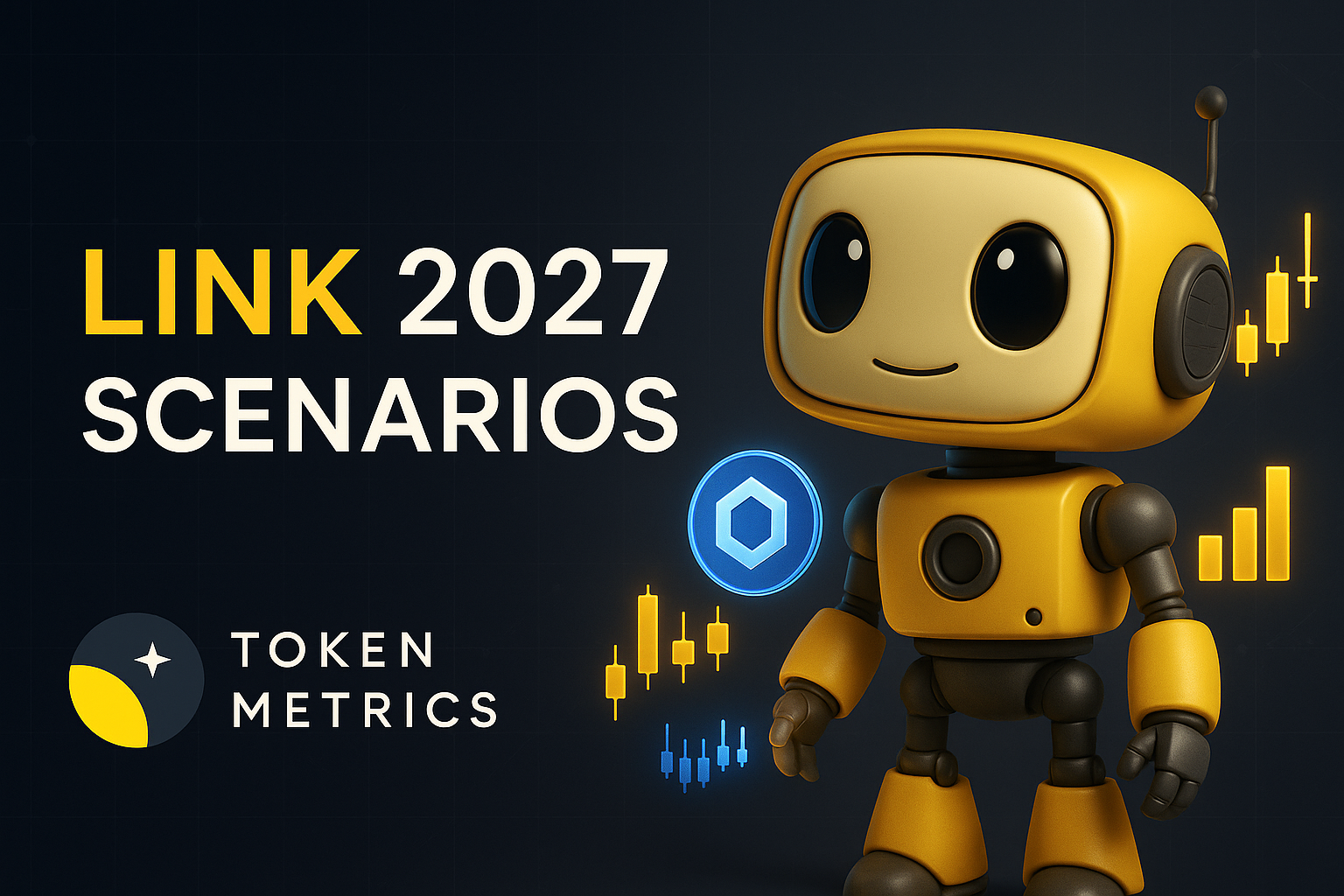Top Crypto Trading Platforms in 2025







%201.svg)
%201.svg)
Big news: We’re cranking up the heat on AI-driven crypto analytics with the launch of the Token Metrics API and our official SDK (Software Development Kit). This isn’t just an upgrade – it's a quantum leap, giving traders, hedge funds, developers, and institutions direct access to cutting-edge market intelligence, trading signals, and predictive analytics.
Crypto markets move fast, and having real-time, AI-powered insights can be the difference between catching the next big trend or getting left behind. Until now, traders and quants have been wrestling with scattered data, delayed reporting, and a lack of truly predictive analytics. Not anymore.
The Token Metrics API delivers 32+ high-performance endpoints packed with powerful AI-driven insights right into your lap, including:
Getting started with the Token Metrics API is simple:
At Token Metrics, we believe data should be decentralized, predictive, and actionable.
The Token Metrics API & SDK bring next-gen AI-powered crypto intelligence to anyone looking to trade smarter, build better, and stay ahead of the curve. With our official SDK, developers can plug these insights into their own trading bots, dashboards, and research tools – no need to reinvent the wheel.
%201.svg)
%201.svg)
The Layer 1 landscape is consolidating as users and developers gravitate to chains with clear specialization. Bitcoin Cash positions itself as a payment-focused chain with low fees and quick settlement for everyday usage.
The scenario projections below map potential outcomes for BCH across different total crypto market sizes. Base cases assume steady usage and listings, while moon scenarios factor in stronger liquidity and accelerated adoption.
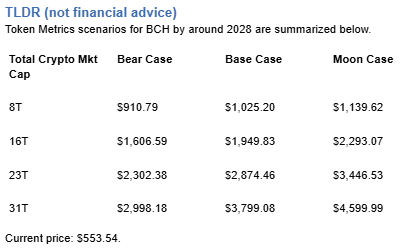
Disclosure
Educational purposes only, not financial advice. Crypto is volatile, do your own research and manage risk.
How to read it: Each band blends cycle analogues and market-cap share math with TA guardrails. Base assumes steady adoption and neutral or positive macro. Moon layers in a liquidity boom. Bear assumes muted flows and tighter liquidity.
TM Agent baseline:
Token Metrics lead metric for Bitcoin Cash, cashtag $BCH, is a TM Grade of 54.81%, which translates to Neutral, and the trading signal is bearish, indicating short-term downward momentum. This implies Token Metrics views $BCH as mixed value long term: fundamentals look strong, while valuation and technology scores are weak, so upside depends on improvements in adoption or technical development. Market context: Bitcoin has been setting market direction, and with broader risk-off moves altcoins face pressure, which increases downside risk for $BCH in the near term.
Live details:
Affiliate Disclosure: We may earn a commission from qualifying purchases made via this link, at no extra cost to you.
Token Metrics scenarios span four market cap tiers, each representing different levels of crypto market maturity and liquidity:
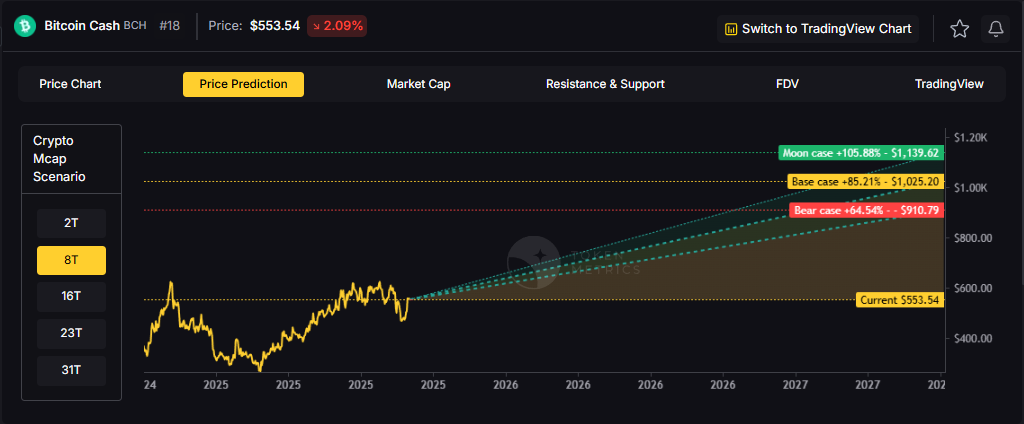


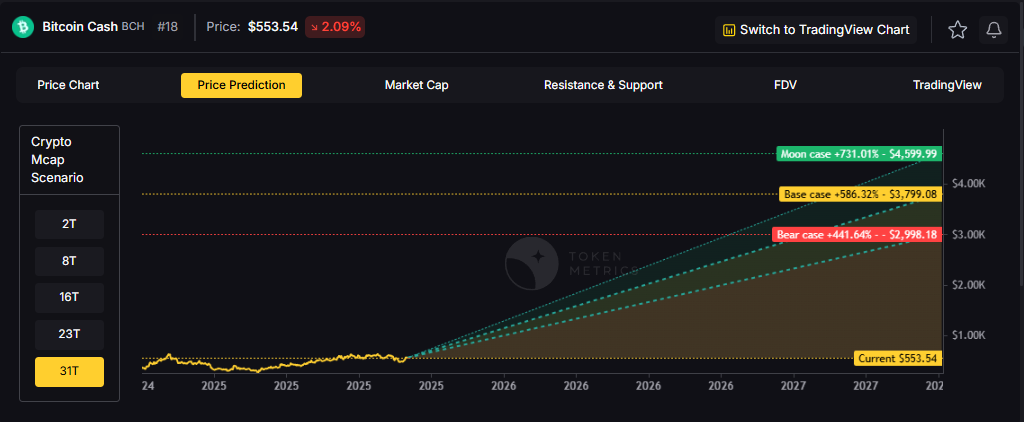
Each tier assumes progressively stronger market conditions, with the base case reflecting steady growth and the moon case requiring sustained bull market dynamics.
Bitcoin Cash represents one opportunity among hundreds in crypto markets. Token Metrics Indices bundle BCH with top one hundred assets for systematic exposure to the strongest projects. Single tokens face idiosyncratic risks that diversified baskets mitigate.
Historical index performance demonstrates the value of systematic diversification versus concentrated positions.
Bitcoin Cash is a peer-to-peer electronic cash network focused on fast confirmation and low fees. It launched in 2017 as a hard fork of Bitcoin with larger block capacity to prioritize payments. The chain secures value transfers using proof of work and aims to keep everyday transactions affordable.
BCH is used to pay transaction fees and settle transfers, and it is widely listed across major exchanges. Adoption centers on payments, micropayments, and remittances where low fees matter. It competes as a payment‑focused Layer 1 within the broader crypto market.
Token Metrics AI provides comprehensive context on Bitcoin Cash's positioning and challenges.
Vision:
Bitcoin Cash (BCH) is a cryptocurrency that emerged from a 2017 hard fork of Bitcoin, aiming to function as a peer-to-peer electronic cash system with faster transactions and lower fees. It is known for prioritizing on-chain scalability by increasing block sizes, allowing more transactions per block compared to Bitcoin. This design choice supports its use in everyday payments, appealing to users seeking a digital cash alternative. Adoption has been driven by its utility in micropayments and remittances, particularly in regions with limited banking infrastructure. However, Bitcoin Cash faces challenges including lower network security due to reduced mining hash rate compared to Bitcoin, and ongoing competition from both Bitcoin and other scalable blockchains. Its value proposition centers on accessibility and transaction efficiency, but it operates in a crowded space with evolving technological and regulatory risks.
Problem:
The project addresses scalability limitations in Bitcoin, where rising transaction fees and slow confirmation times hinder its use for small, frequent payments. As Bitcoin evolved into a store of value, a gap emerged for a blockchain-based currency optimized for fast, low-cost transactions accessible to the general public.
Solution:
Bitcoin Cash increases block size limits from 1 MB to 32 MB, enabling more transactions per block and reducing congestion. This on-chain scaling approach allows for faster confirmations and lower fees, making microtransactions feasible. The network supports basic smart contract functionality and replay protection, maintaining compatibility with Bitcoin's core architecture while prioritizing payment utility.
Market Analysis:
Bitcoin Cash operates in the digital currency segment, competing with Bitcoin, Litecoin, and stablecoins for use in payments and remittances. While not the market leader, it occupies a niche focused on on-chain scalability for transactional use. Its adoption is influenced by merchant acceptance, exchange liquidity, and narratives around digital cash. Key risks include competition from layer-2 solutions on other blockchains, regulatory scrutiny of cryptocurrencies, and lower developer and miner activity compared to larger networks. Price movements are often tied to broader crypto market trends and internal protocol developments. Despite its established presence, long-term growth depends on sustained utility, network security, and differentiation in a market increasingly dominated by high-throughput smart contract platforms.
Fundamental Grade: 80.41% (Community 62%, Tokenomics 100%, Exchange 100%, VC —, DeFi Scanner 72%).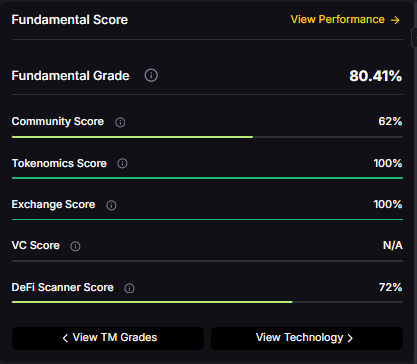
Technology Grade: 29.63% (Activity 22%, Repository 70%, Collaboration 48%, Security —, DeFi Scanner 72%).
Can BCH reach $3,000?
Based on the scenarios, BCH could reach $3,000 in the 23T moon case and 31T base case. The 23T tier projects $3,446.53 in the moon case. Not financial advice.
Can BCH 10x from current levels?
At current price of $553.54, a 10x would reach $5,535.40. This falls within the 31T base and moon cases. Bear in mind that 10x returns require substantial market cap expansion. Not financial advice.
Should I buy BCH now or wait?
Timing depends on your risk tolerance and macro outlook. Current price of $553.54 sits below the 8T bear case in our scenarios. Dollar-cost averaging may reduce timing risk. Not financial advice.
Want exposure? Buy BCH on MEXC
Disclosure
Educational purposes only, not financial advice. Crypto is volatile, do your own research and manage risk.
%201.svg)
%201.svg)
Infrastructure protocols become more valuable as the crypto ecosystem scales and relies on robust middleware. Chainlink provides critical oracle infrastructure where proven utility and deep integrations drive long-term value over retail speculation. Increasing institutional adoption raises demand for professional-grade data delivery and security.
Token Metrics projections for LINK below span multiple total market cap scenarios from conservative to aggressive. Each tier assumes different levels of infrastructure demand as crypto evolves from speculative markets to institutional-grade systems. These bands frame LINK's potential outcomes into 2027.

Disclosure
Educational purposes only, not financial advice. Crypto is volatile, do your own research and manage risk.
How to read it: Each band blends cycle analogues and market-cap share math with TA guardrails. Base assumes steady adoption and neutral or positive macro. Moon layers in a liquidity boom. Bear assumes muted flows and tighter liquidity.
TM Agent baseline: Token Metrics lead metric for Chainlink, cashtag $LINK, is a TM Grade of 23.31%, which translates to a Sell, and the trading signal is bearish, indicating short-term downward momentum. This means Token Metrics currently does not endorse $LINK as a long-term buy at current conditions.
Live details: Chainlink Token Details
Affiliate Disclosure: We may earn a commission from qualifying purchases made via this link, at no extra cost to you.
Token Metrics scenarios span four market cap tiers, each representing different levels of crypto market maturity and liquidity:
8T: At an 8 trillion dollar total crypto market cap, LINK projects to $26.10 in bear conditions, $30.65 in the base case, and $35.20 in bullish scenarios.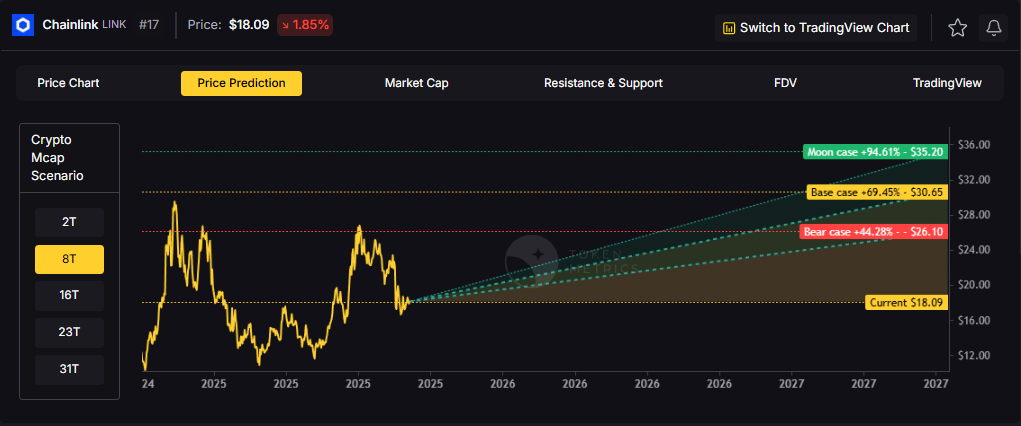
16T: Doubling the market to 16 trillion expands the range to $42.64 (bear), $56.29 (base), and $69.95 (moon).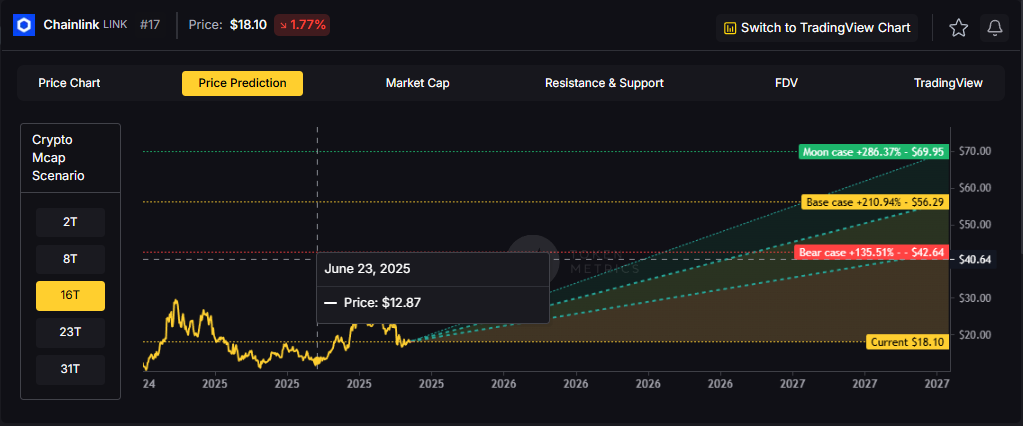
23T: At 23 trillion, the scenarios show $59.18, $81.94, and $104.70 respectively.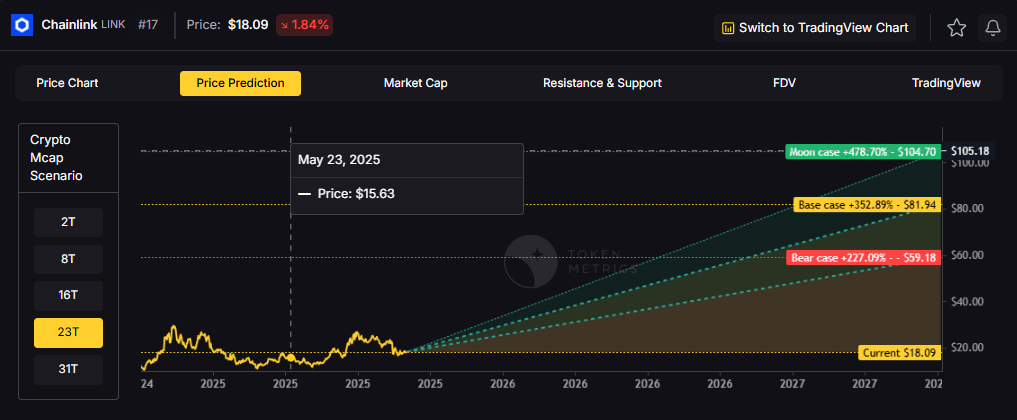
31T: In the maximum liquidity scenario of 31 trillion, LINK could reach $75.71 (bear), $107.58 (base), or $139.44 (moon).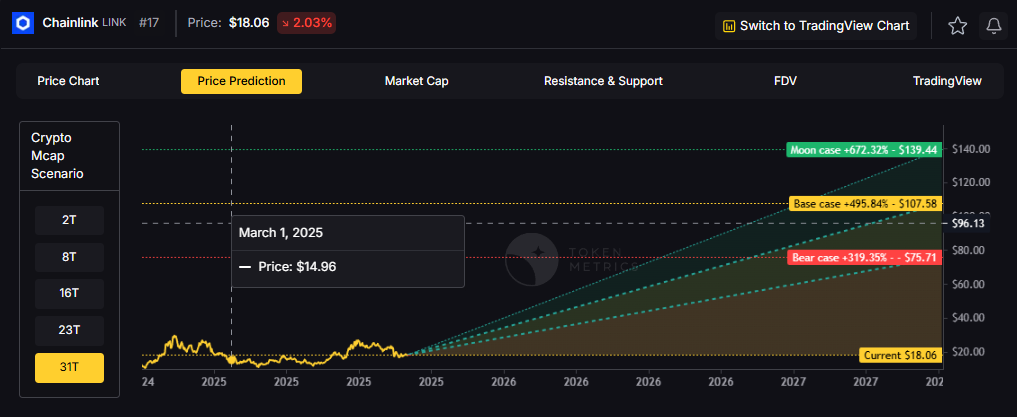
Chainlink represents one opportunity among hundreds in crypto markets. Token Metrics Indices bundle LINK with top one hundred assets for systematic exposure to the strongest projects. Single tokens face idiosyncratic risks that diversified baskets mitigate.
Historical index performance demonstrates the value of systematic diversification versus concentrated positions.
Chainlink is a decentralized oracle network that connects smart contracts to real-world data and systems. It enables secure retrieval and verification of off-chain information, supports computation, and integrates across multiple blockchains. As adoption grows, Chainlink serves as critical infrastructure for reliable data feeds and automation.
The LINK token is used to pay node operators and secure the network’s services. Common use cases include DeFi price feeds, insurance, and enterprise integrations, with CCIP extending cross-chain messaging and token transfers.
Vision: Chainlink aims to create a decentralized, secure, and reliable network for connecting smart contracts with real-world data and systems. Its vision is to become the standard for how blockchains interact with external environments, enabling trust-minimized automation across industries.
Problem: Smart contracts cannot natively access data outside their blockchain, limiting their functionality. Relying on centralized oracles introduces single points of failure and undermines the security and decentralization of blockchain applications. This creates a critical need for a trustless, tamper-proof way to bring real-world information onto blockchains.
Solution: Chainlink solves this by operating a decentralized network of node operators that fetch, aggregate, and deliver data from off-chain sources to smart contracts. It uses cryptographic proofs, reputation systems, and economic incentives to ensure data integrity. The network supports various data types and computation tasks, allowing developers to build complex, data-driven decentralized applications.
Market Analysis: Chainlink is a market leader in the oracle space and a key infrastructure component in the broader blockchain ecosystem, particularly within Ethereum and other smart contract platforms. It faces competition from emerging oracle networks like Band Protocol and API3, but maintains a strong first-mover advantage and widespread integration across DeFi, NFTs, and enterprise blockchain solutions. Adoption is driven by developer activity, partnerships with major blockchain projects, and demand for secure data feeds. Key risks include technological shifts, regulatory scrutiny on data providers, and execution challenges in scaling decentralized oracle networks. As smart contract usage grows, so does the potential for oracle services, positioning Chainlink at the center of a critical niche, though its success depends on maintaining security and decentralization over time.
Fundamental Grade: 74.58% (Community 81%, Tokenomics 100%, Exchange 100%, VC —, DeFi Scanner 17%).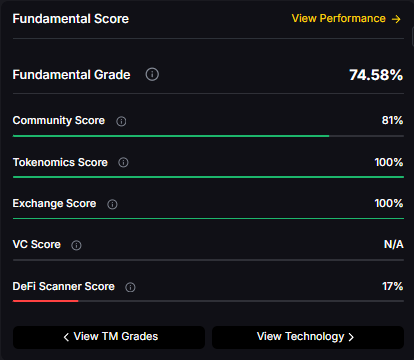
Technology Grade: 88.50% (Activity 81%, Repository 72%, Collaboration 100%, Security 86%, DeFi Scanner 17%).
Can LINK reach $100?
Yes. Based on the scenarios, LINK could reach $100+ in the 23T moon case. The 23T tier projects $104.70 in the moon case. Not financial advice.
What price could LINK reach in the moon case?
Moon case projections range from $35.20 at 8T to $139.44 at 31T. These scenarios assume maximum liquidity expansion and strong Chainlink adoption. Not financial advice.
Should I buy LINK now or wait?
Timing depends on risk tolerance and macro outlook. Current price of $18.09 sits below the 8T bear case in the scenarios. Dollar-cost averaging may reduce timing risk. Not financial advice.
Track live grades and signals: Token Details
Want exposure? Buy LINK on MEXC
Disclosure
Educational purposes only, not financial advice. Crypto is volatile, do your own research and manage risk.
Discover the full potential of your crypto research and portfolio management with Token Metrics. Our ratings combine AI-driven analytics, on-chain data, and decades of investing expertise—giving you the edge to navigate fast-changing markets. Try our platform to access scenario-based price targets, token grades, indices, and more for institutional and individual investors. Token Metrics is your research partner through every crypto market cycle.
%201.svg)
%201.svg)
The crypto market is tilting bullish into 2026 as liquidity, infrastructure, and participation improve across the board. Clearer rules and standards are reshaping the classic four-year cycle, flows can arrive earlier, and strength can persist longer than in prior expansions.
Institutional access is widening through ETFs and custody, while L2 scaling and real-world integrations help sustain on‑chain activity. This healthier backdrop frames our scenario work for HYPE. The ranges below reflect different total crypto market sizes and the share Hyperliquid could capture under each regime.
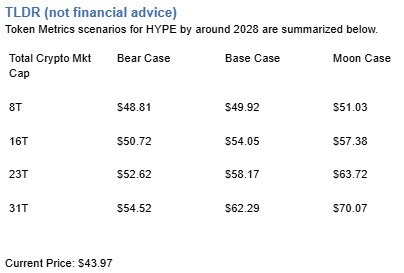
Disclosure
Educational purposes only, not financial advice. Crypto is volatile, do your own research and manage risk.
How to read it: Each band blends cycle analogues and market-cap share math with TA guardrails. Base assumes steady adoption and neutral or positive macro. Moon layers in a liquidity boom. Bear assumes muted flows and tighter liquidity.
TM Agent baseline: Token Metrics TM Grade is 73.9%, a Buy, and the trading signal is bearish, indicating short-term downward momentum. This means Token Metrics judges HYPE as fundamentally attractive over the long term, while near-term momentum is negative and may limit rallies.
Live details: Hyperliquid Token Details
Affiliate Disclosure: We may earn a commission from qualifying purchases made via this link, at no extra cost to you.
Scenario Analysis
Token Metrics scenarios span four market cap tiers, each representing different levels of crypto market maturity and liquidity:
8T: At an 8 trillion dollar total crypto market cap, HYPE projects to $48.81 in bear conditions, $49.92 in the base case, and $51.03 in bullish scenarios.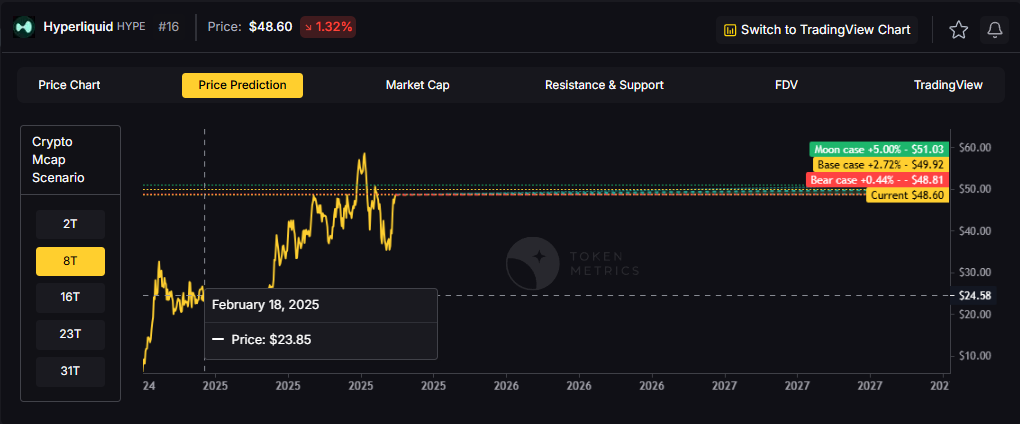
16T: Doubling the market to 16 trillion expands the range to $50.72 (bear), $54.05 (base), and $57.38 (moon).
23T: At 23 trillion, the scenarios show $52.62, $58.17, and $63.72 respectively.
31T: In the maximum liquidity scenario of 31 trillion, HYPE could reach $54.52 (bear), $62.29 (base), or $70.07 (moon).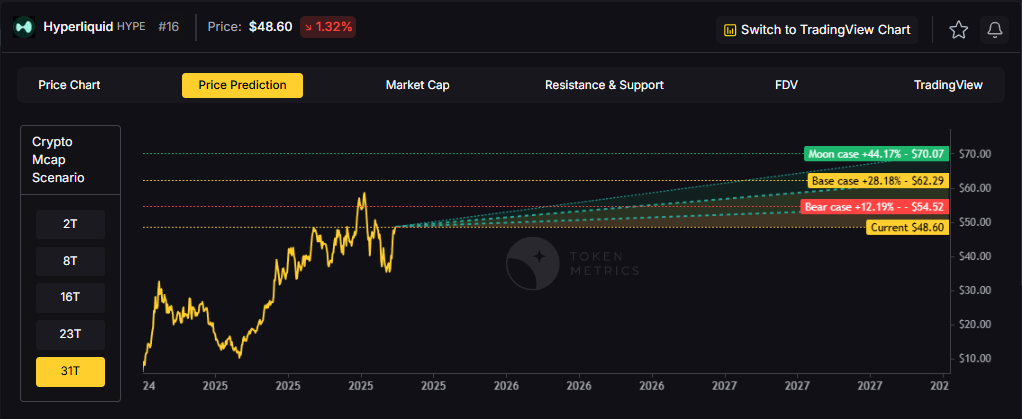
Each tier assumes progressively stronger market conditions, with the base case reflecting steady growth and the moon case requiring sustained bull market dynamics.
Diversification matters. HYPE is compelling, yet concentrated bets can be volatile. Token Metrics Indices hold HYPE alongside the top one hundred tokens for broad exposure to leaders and emerging winners.
Our backtests indicate that owning the full market with diversified indices has historically outperformed both the total market and Bitcoin in many regimes due to diversification and rotation.
Hyperliquid is a decentralized exchange focused on perpetual futures with a high-performance order book architecture. The project emphasizes low-latency trading, risk controls, and capital efficiency aimed at professional and retail derivatives traders. Its token, HYPE, is used for ecosystem incentives and governance-related utilities.
Can HYPE reach $60?
Yes, the 23T and 31T tiers imply ranges above $60 in the Base and Moon bands, though outcomes depend on liquidity and adoption. Not financial advice.
Is HYPE a good long-term investment?
Outcome depends on adoption, liquidity regime, competition, and supply dynamics. Diversify and size positions responsibly.
Disclosure
Educational purposes only, not financial advice. Crypto is volatile, do your own research and manage risk.
Token Metrics delivers AI-based crypto ratings, scenario projections, and portfolio tools so you can make smarter decisions. Discover real-time analytics on Token Metrics.

%201.svg)
%201.svg)
Investing in crypto can be intimidating, especially when a bear market is set in. And if you want to kickstart your 2023, here are a few projects you can look forward to. Note that some of these are not launched yet while some are trading.
Remember, the idea behind this is to Buy Low & Sell High; i.e., you have to get in early, accumulate, and, once you see the risk on you, start taking profitable steps to yield good returns.
Let's see what cryptocurrency projects you might need to look out for investment in 2023.
Airstack provides data infrastructure for web3. Their APIs enable easy querying across projects and blockchains — powering a new world of data-aware experiences. It’s founded in 2014 by Ariel Seidman and Ben Wong, which now stands at a total funding of $23M - so, it's worth looking into.
Airchains is a popular middleware SaaS platform that allows you to build and deploy your own dApp on any of the chains below:
Founded by Ankur Rakhi Sinha in 2021, it stands at a total funding of over $638M as of now. If you are a developer, who doesn’t like building tons of services all by yourself, then this is for you. The inbuilt features are something to look forward to.
Nolus is the world's first DeFi Lease platform. It might sound risky at first, but let's say you borrow collateral that's more capital efficient; you can borrow 150% of your collateral but is locked in their ecosystem, and you can't get out until it's repaid. It does take a while to get it, but it's worth it.
The aim is to combine the leverage of Tradfi and DeFi with the advantages that decentralization brings to the table. With the Nolus DeFi Lease, users will hold the complete authority of customizing the parameters of the on-chain contractual agreement.
Nibiru is an open-sourced platform and a member of the interconnected family of Cosmos Ecosystem. It's a competitor for dYdX; it can unify leveraged derivatives trading, staking, and bonded liquidity provision into a seamless user experience. It enables users with over 40 blockchains to trade with leverage using a suite of composable dApps.
Nillion is a secure processing layer for web3 which is equipped with new capabilities and use cases for blockchain and the real world. It focuses on quick decentralized computation. Andrew Masanto, a serial entrepreneur and investor, is the Co-founder of Nillion and as of Jan 2023, it has a standing funding of over $20M. And it can be positive choice to invest in the near future.
Blockless helps you launch your project on a decentralized global network. It is a WASM-based verifiable serverless functions platform that can ensures top-class security and reliability. They recently introduced Blockless ZK, a prover as a service solution powered by zkWASM. This is an added feature to guarantee the execution correctness to your WASM apps with just a single click.
Hivemapper is the world's first crypto-enabled dashcam representing a fundamental shift in how maps are built by enabling people using dashcams to mine their cryptocurrency, HONEY.
It's yet to be launched, but you can earn tokens to drive. The dashcam costs around 600 bucks, and it's a no-brainer to get started. This has a good potential of 100x because if you are already driving, you might as well get paid for it.
Canto is a cutting-edge Layer-1 blockchain solution that aims to bring the benefits of decentralized finance (DeFi) to a wider audience. By leveraging the power of free public infrastructure, Canto aims to create a new type of digital commons where individuals can take control of their financial assets and engage in a wide range of financial transactions without having to rely on traditional financial intermediaries.
Moonbeam is a multi-chain platform that bridges dApps from Polkadot and Cosmos. It is an Ethereum-compatible smart contract parachain on Polkadot with minimal configuration changes and pre-built integrations.
Mina Protocol is the world’s lightest blockchain powered by participants. Mina is building a low-tech infrastructure for the secure, democratic future - as we all anticipate. There is no risk of your personal information being hacked or sold. You are the only one who owns your data, and it never leaves your device.
Harmony is an open-sourced fast blockchain; running the transactions of Ethereum applications in as little as 2 seconds. It is also 100x cheaper compared to others in the market. The average cost per transaction lies at around $0.0001.
The three pillars that Harmony thrives to balance are: scalability, security, and decentralization.
It encourages random state sharding with a guaranteed security of offering 250 nodes per shard and cryptographic randomness to re-shard regularly.
GMX is a platform that offers up to 50x leverage directly from your wallet for trading BTC, ETH, AVAX and other top crypto currencies. This reduces liquidation risks, saves on costs, and offers a simple swap interface.
The information provided on this website does not constitute investment advice, financial advice, trading advice, or any other sort of advice and you should not treat any of the website's content as such.
Token Metrics does not recommend that any cryptocurrency should be bought, sold, or held by you. Do conduct your own due diligence and consult your financial advisor before making any investment decisions.

%201.svg)
%201.svg)
Cryptocurrency has been around for over a decade, and it's quickly becoming a popular way to make money online. With the recent rise in the value of Bitcoin, Ethereum, and other cryptocurrencies, more and more people are looking for ways to capitalize on this new digital asset. This article will look at eight proven methods for making money with crypto in 2024 and beyond.
Whether a beginner or a seasoned investor, you'll find something here that you can use to make money with your cryptocurrency investments. Let’s dive in.
If you're interested in making money with crypto, the first step is to do your research. It would be best if you understood the different types of cryptocurrency, the various methods of making money with crypto, and the pros and cons of each. Once you have a good understanding, you can start investing.
Finding a reliable and secure way to store your cryptocurrency is equally significant. You can use a hardware wallet, a software wallet, or an online exchange. Whichever you choose, make sure it's secure, and you can trust it with your money.
Following are the ways to make money with crypto in 2024.
The most common way to make money with crypto is through mining. Mining verifies transactions on the blockchain and adds new blocks of data to the chain. By doing this, miners are rewarded with cryptocurrency for their effort. Mining can be done with specialized hardware or with cloud mining services.
You don't need to purchase or maintain hardware with cloud mining, but the rewards are usually lower than with hardware mining. It's important to note that mining cryptocurrency is not easy and requires a lot of electricity, so it's essential to do your research before getting started.
Crypto staking is a method of investing in cryptocurrency that involves holding a certain amount of coins in your wallet for a certain period. By doing this, you are rewarded with a slight interest in your investment. So, you can earn passive income from your crypto investments.
The interest you can earn depends on the cryptocurrency and the number of coins you are staking. Some cryptocurrencies offer higher rewards than others, so it's crucial to do your research first.
Trading cryptocurrency is another popular way to make money with crypto. This method involves buying and selling cryptocurrency on a crypto exchange. You can take advantage of the price fluctuations and profit by doing so.
Note that trading cryptocurrency is risky and can result in losses. Therefore, learn your basics before you start trading.
Investing in cryptocurrency is a great way to make money with crypto. You can invest in individual coins, such as Bitcoin and Ethereum, or you can invest in a cryptocurrency index fund. This is a great way to diversify your portfolio and spread your risk.
When investing in cryptocurrency, make it a point to research and understand the risks you will take.
Cryptocurrency lending is another way to monetize crypto. It involves lending your cryptocurrency to someone else in exchange for interest. The interest rate you receive will depend on the type of cryptocurrency you are lending and the amount you are lending.
Cryptocurrency can help you earn interest on your investments. It is done through a " yield farming process," where you lend your cryptocurrency to a platform in exchange for interest. The amount of interest you gain will solely depend on the platform and the type of cryptocurrency you are lending.
There are many platforms offering yield farming opportunities, but not all of them are safe or reliable. So, pick the trustworthy ones.
Many cryptocurrency exchanges offer affiliate programs allowing you to earn commissions on referred customers. By referring customers to an exchange, you can earn a percentage of the transaction fees they pay. It is a great way to make money with crypto without having to do any trading or investing.
Affiliate programs can be very competitive, so list out your best finds. Many great affiliate programs are available in the market, so research and find the most profitable ones.
Initial Coin Offerings (ICOs) are a type of investment involving buying a company's token issued in exchange for cryptocurrency. ICOs are a great way to make money with crypto, as they can offer high returns on your investment.
However, it's essential to be aware of the risks involved. Many ICOs are scams and can result in losses, so ensure the ICO is legitimate before investing.
Research, as mentioned, is the goldmine for your crypto investment. It’s that unavoidable prerequisite that can help you predict and decide your crypto strategy. But, as you know, there are so many research platforms available up and live in the market and it’s quite challenging to pick the best one for you.
So, we made it easy for you.
We, at Token Metrics, offer comprehensive crypto data which can help you make an informed investment decision. Based on the data our AI tool articulates, you can find the best coins for your portfolio, a complete end-to-end analysis, touch points and everything else you need to make the final call.
Making money with crypto is a great way to generate passive income and grow your wealth. Be it any method, before getting started; it's essential to do thorough research and understand the risk as well as the potential. You can make money with your crypto investments in 2024 and beyond with the right analytical approach.
The information provided on this website does not constitute investment advice, financial advice, trading advice, or any other advice, and you should not treat any of the website's content as such.
Token Metrics does not recommend buying, selling, or holding any cryptocurrency. Conduct your due diligence and consult your financial advisor before making investment decisions.

%201.svg)
%201.svg)
Solana (SOL) is a high-performance blockchain platform that aims to provide scalability and speed for decentralized applications (dApps) and token transactions. Solana was founded in 2017 by Anatoly Yakovenko and since then, it has attracted a growing community of developers and users.
Solana was first introduced in 2017 by Anatoly Yakovenko, a software engineer with over 20 years of experience in the industry. Yakovenko had previously worked on high-performance systems at companies such as Qualcomm and Intel. In 2018, Solana raised $20 million in a private token sale. Since then, the Solana project has grown significantly, with a number of decentralized applications and platforms built on top of the Solana blockchain.
Solana's unique consensus algorithm, called "Proof of Stake Time" (PoST), enables the network to process over 65,000 transactions per second (TPS) while maintaining a high level of security. This is a significant improvement over other blockchain platforms such as Ethereum and Bitcoin, which are limited to around 15 and 7 TPS respectively.
In contrast to traditional proof of work (PoW) algorithms, where miners compete to solve mathematical problems, Solana's PoST algorithm allows validators to stake their tokens to secure the network. These validators are then chosen randomly to create new blocks and validate transactions. This results in a more energy-efficient and scalable network compared to other blockchain platforms.
Now, let’s see how Solana can benefit you.
There are several benefits to using Solana as a blockchain platform for dApps and token transactions. Here are a few of the key advantages:
Solana has a wide range of potential use cases, from decentralized finance (DeFi) to gaming and prediction markets.
In the DeFi space, Solana has become an important player, with several projects building on the Solana blockchain. Some of the popular DeFi projects on Solana include Serum, a decentralized exchange (DEX) built on Solana, and Jupiter Aggregator, a swap aggregator and infrastructure for Solana.
Solana's high performance and low latency also make it well-suited for gaming and other high-throughput applications. The Solana blockchain has already been used to launch a number of games, including STEPN, a run-to-earn game.
Additionally, many projects are being built on Solana for other industries such as real estate, identity verification, supply chain management, logistics, and many more.
Like any investment, the value of Solana (SOL) can be highly volatile and is subject to market conditions. Some experts have highlighted Solana's high scalability, low fees and energy efficiency as factors that could drive its crypto future growth. However, it's important to do your own research and consider your own risk tolerance before making any investment decisions.
Solana can be purchased on a variety of cryptocurrency exchanges such as Binance, Serum, and Bitmax. To purchase Solana, you will first need to set up a digital wallet that supports Solana, such as a Ledger hardware wallet. Once you have a wallet, you can deposit funds onto the exchange and then use those funds to purchase Solana.
The future of Solana (SOL) is highly dependent on the continued development and adoption of the Solana platform. As more developers and users become attracted to the platform's high scalability and low fees, Solana's value could continue to grow. Additionally, Solana's PoST consensus algorithm is still untested at a large scale, and its long term success is uncertain.
In conclusion Solana has a lot of potential and it has been on a steady rise but still a lot of uncertainty in the long term. It's important to do your own research and consider your own risk tolerance before making any investment.
Solana is a high-performance blockchain platform that is well-suited for a wide range of decentralized applications. Its unique consensus algorithm, "Proof of Stake Time" (PoST), enables the network to process large numbers of transactions per second, with low latency and low fees. The Solana network is also highly decentralized, providing security and integrity for the network. With its growing community of developers and users, Solana is well-positioned to become a major player in the blockchain space

%201.svg)
%201.svg)
Polygon (formerly known as Matic Network) is a protocol for building and connecting Ethereum-compatible blockchain networks. It is designed to provide faster and cheaper transactions on the Ethereum network by using side chains and an adapted version of the Plasma framework.
It also offers a wide range of:
The history of Polygon Matic dates back to 2017 when the project was founded by Jaynti Kanani and Sandeep Nailwal. In 2021, the project took up a rebranding and went from Matic Network to Polygon. This was done in the light of reflecting a broader focus on providing infrastructure for a wide range of blockchain use cases.
With Polygon MATIC, users can easily create and manage their own decentralized applications, securely store and transfer assets, and even trade digital assets. With its powerful features and benefits, Polygon MATIC can be a great tool for you to leverage the power of the blockchain. Find out how it can benefit you in the best ways possible below.
Polygon MATIC has several benefits that make it a great blockchain solution. Here are a few of its top benefits that you need to be aware of:
The Polygon MATIC blockchain is a secure and reliable blockchain solution. It uses a distributed ledger technology that is decentralized and peer-to-peer. This means that there is no single point of failure and it is not controlled by a single entity. This makes it secure and reliable. When it comes to security, the Polygon MATIC blockchain has many features.
Some of these features are discussed below:
The cost of using Polygon MATIC will depend on your usage. The more you use the platform, the higher the cost will be. You can also choose to outsource your needs and use Polygon MATIC as a service.
Here are a few things you should know about the Polygon MATIC cost:
Note: These prices may have changed due to change in MATIC's price.
These are the costs of using Polygon MATIC as a service. For more details on the cost, visit their website.
As for whether Polygon is a good investment, it's important to remember that the cryptocurrency market is highly volatile and that investing in any cryptocurrency carries a high level of risk. It's important to do your own research and carefully consider your investment options before making any decisions.
If you're interested in buying MATIC, you can do so on a number of cryptocurrency exchanges that offer it. Some popular options include Binance, Coinbase, and Kraken. Be sure to carefully compare the fees and features of different exchanges before choosing one to use. Below are the 5 simple steps that you can follow to get your own Polygon:
Great, but, do we know where Polygon is headed in the future?
It's difficult to predict the future of Polygon with certainty, but the project has gained significant traction in the cryptocurrency community and has the potential to continue growing and gaining adoption in the future. However, as with any investment, it's important to be aware of the risks and to carefully consider your options before making any decisions.
Token Metrics is happy to provide you with AI-driven market updates and information regarding the crypto world but it is you who needs to be the decision maker when it comes to your crypto investments.
Polygon (formerly Matic Network) offers innovative technology that could potentially democratize blockchain through the creation of customized, interoperable networks. While it's difficult to predict the future performance of MATIC, the project has a strong team and partnerships with well-known companies.
However, as with any cryptocurrency investment, there is a high level of risk and it's important to carefully consider all options before making any decisions. Blockchain technology is still in its early stages and it may be more profitable to invest in the technology itself rather than just the hype. It's also important to exercise caution when building a cryptocurrency portfolio.
Disclaimer: The information provided on this website does not constitute investment/trading/financial advice and you should not treat any of the website’s content as such. Token Metrics does not recommend that any cryptocurrency should be bought, sold, or held by you. Do conduct your own due diligence and consult your financial advisor before making any investment decisions. We only offer comprehensive information which may change according to time.
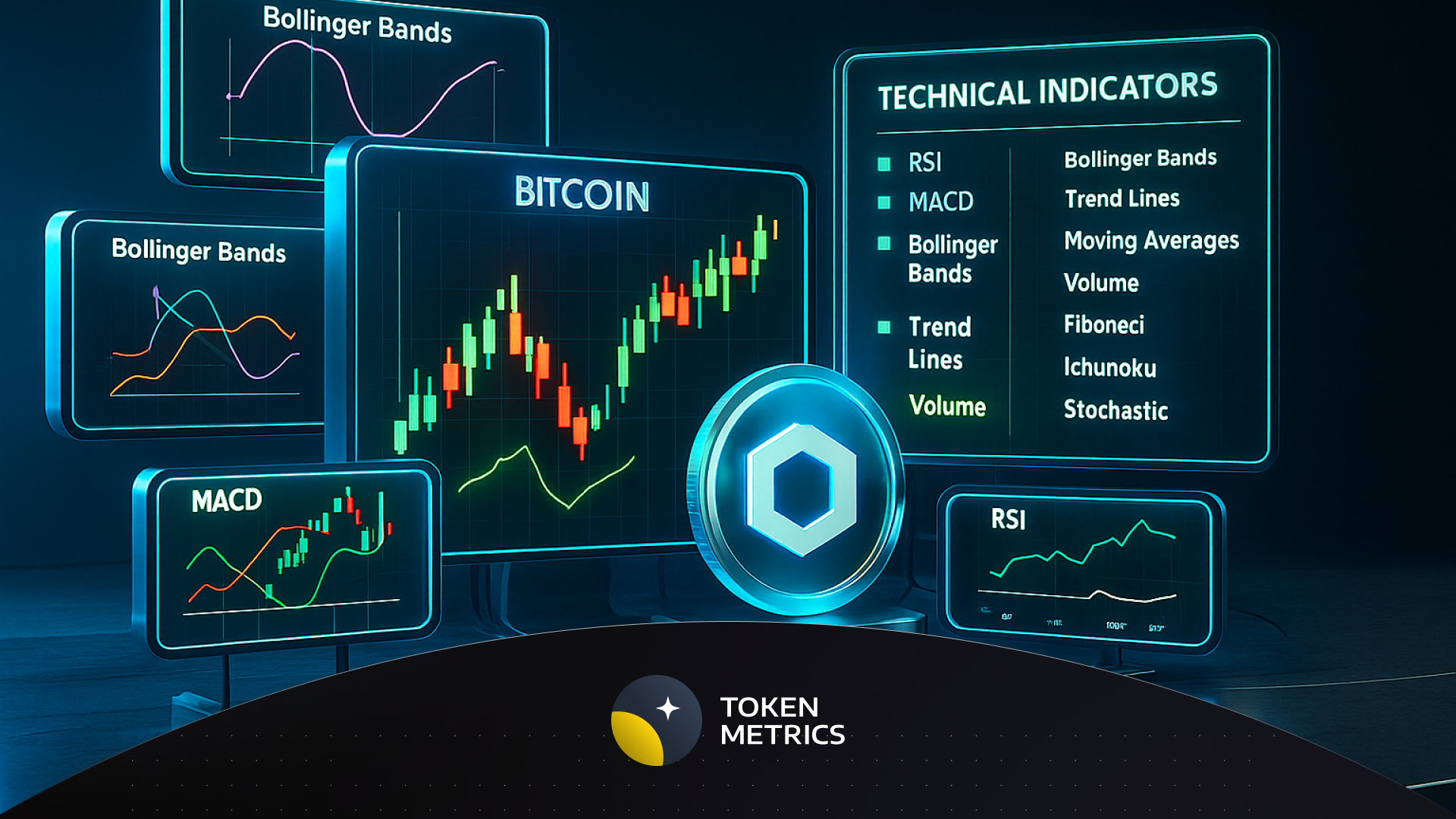
%201.svg)
%201.svg)
Your search for best crypto indicators to trade ends here. But before we start, let's briefly cover the overview of indicators.
Indicators are mathematical calculations based on the price and/or volume of an asset. They can be used to identify trends, measure volatility, and provide signals for trades.
With the help of indicators, traders can:
Trading View is one of the most popular platforms that offers a range of charting and analysis tools, or indicators, to help traders gain an edge in the cryptocurrency market.
Whether you are a beginner or an experienced trader, these crypto indicators can help you maximize your profits and minimize your risks.
By taking the time, one can understand how these crypto indicators work, and how you can set up your trading strategies to maximize profits accordingly.
That said, there are hundreds of pre-built indicators available, but sometimes you may want to create your own custom indicator to fit your specific crypto trading strategy.
For Beginners - New crypto traders can benefit from the built-in trading strategies, which are readily available and are designed to help them identify trading opportunities.
For Experts - Experienced crypto traders can use Trading View to create their own trading strategies and take advantage of market trends on a deeper level.
Here at Token Metrics, we worked hard to create a Trading View Indicator that powers your trading decisions by removing emotions, saving time, and improving risk-adjusted returns.
If you are someone looking for the best crypto trading indicators to use this year, we did the research for you.
Here are top crypto indicators you can use today.
A moving average is a simple yet effective indicator that helps smooth out price action by filtering out noise and highlighting the overall trend. There are various types of moving averages, including simple, exponential, and weighted, each with its own characteristics and uses.
This indicator uses the average price of the stock over a specified number of periods. It is an extremely popular technical analysis tool used to identify trend direction and forecast future price movements.
The Relative Strength Index (RSI) is a momentum indicator that uses the speed and direction of price movements to determine the health of an asset.
Bollinger Bands are one of the most trusted indicators used by traders. It is a momentum indicator that uses standard deviation to determine the price trend. The indicator includes two lines: a moving average and a standard deviation band. The moving average line acts as a trend indicator. The standard deviation band acts as a volatility indicator.
The OBV is a volume-based indicator that reflects the relationship between price and volume. It can be used to identify buying and selling pressure, as well as potential trend changes.
The Ichimoku Cloud, also known as the Ichimoku Kinko Hyo, is a comprehensive technical analysis tool that includes several indicators, such as the kumo (cloud), senkou span (leading span), and kijun sen (baseline). It helps identify trend direction, strength, and potential areas of support and resistance in the market.
The MACD is a trend-following momentum indicator that uses the difference between two moving averages to identify buying and selling opportunities. It is often used in conjunction with the MACD histogram, which helps visualize the relationship between the MACD line and the signal line.
Based on the work of Leonardo Fibonacci, the Fibonacci retracement tool is used to identify potential support and resistance levels by plotting horizontal lines at key Fibonacci levels. It is often used in conjunction with trend lines and other technical indicators to confirm trade signals.
The stochastic oscillator is a momentum indicator that uses the closing price of an asset to identify overbought and oversold conditions. It is often used in conjunction with the moving average to filter out the noise and improve the accuracy of the signal.
The Aroon indicator is a trend-following tool that uses the time between the highest high and the lowest low to identify the trend direction and strength. It is often used in conjunction with other technical indicators to confirm trade signals.
On-chain metrics are data points that provide insights into the underlying health and activity of a cryptocurrency or token. Examples of on-chain metrics include network value to transaction ratio (NVT), miners' revenue, daily active addresses and more.
There are many indicators to help you make more money when trading cryptocurrencies. But to be certain of the price movement of an asset, is is advised to use multiple indicators to find if they're all hinting at the same outcome.
This is why we worked hard to create our own Token Metrics Trading View Indicator that takes into account multiple factors to minimze risks and maximize potential returns.
The information provided on this website does not constitute investment advice, financial advice, trading advice, or any other sort of advice and you should not treat any of the website's content as such.
Token Metrics does not recommend that any cryptocurrency should be bought, sold, or held by you. Do conduct your own due diligence and consult your financial advisor before making any investment decisions.

%201.svg)
%201.svg)
Cryptocurrencies have revolutionized the way people make payments and investments. With the rise of digital assets, Cryptocurrency APIs have become essential tools for developers to build applications that can interact with the blockchain. An API allows you to connect to a third-party service and retrieve or submit data in a standardized format to a website or application.
Token Metrics Crypto API is the best cryptocurrency API currently available. Use Token Metrics crypto API for real-time prices, on-chain data, and AI crypto trading signals from one powerful crypto API. This crypto API is built for speed and accuracy to help you trade smarter instantly.We will look into the features and advantages, discuss the different types of APIs, and learn how to use them to create powerful applications. We will also cover the pros and cons of using these APIs, and provide examples of how they can be used. Last but not least, we will discuss the pricing of these APIs and provide some best practices for using them.
Cryptocurrency APIs are Application Programming Interfaces (APIs) that allow developers to access and integrate cryptocurrency data into their applications. APIs provide access to a variety of data such as prices, transactions, and blockchains. With the help of these APIs, developers can create powerful applications that can interact with the crypto world.
The most obvious benefit of using cryptocurrency APIs is that they provide access to a wealth of data that can be used to build powerful applications. The APIs provide access to real-time data. This data can be used to create applications that can monitor the market, track transactions, and even make predictions about the future of the crypto world.
Another benefit of using cryptocurrency APIs is that they are easy to use and provide a consistent and reliable source of data. The APIs are designed to be user friendly, so developers don’t have to worry about getting bogged down in technical details. The APIs also provide reliable, up-to-date data that can be used to create accurate and reliable applications.
Cryptocurrency APIs can also save developers a lot of time and effort. Instead of having to manually gather data, developers can simply use the APIs and get the data they need. This can save developers a lot of time and effort, allowing them to focus on other aspects of their applications.
There are a variety of cryptocurrency APIs available, each with its own set of features and advantages. The most common types of APIs are:
Now that we’ve discussed the benefits and types of crypto APIs, let’s look at the best APIs to get crypto data today.
1. Token Metrics: Token Metrics crypto API offers real-time prices, on-chain data, and AI trading signals from one powerful crypto API. It is the best crypto API built for speed and accuracy to help you trade smarter instantly. Token Metrics is an AI driven platform which enables its users research thousands of cryptocurrencies in an automated way, without manually going through coins individually. Use Token Metrics crypto API for fast and most accurate crypto data.
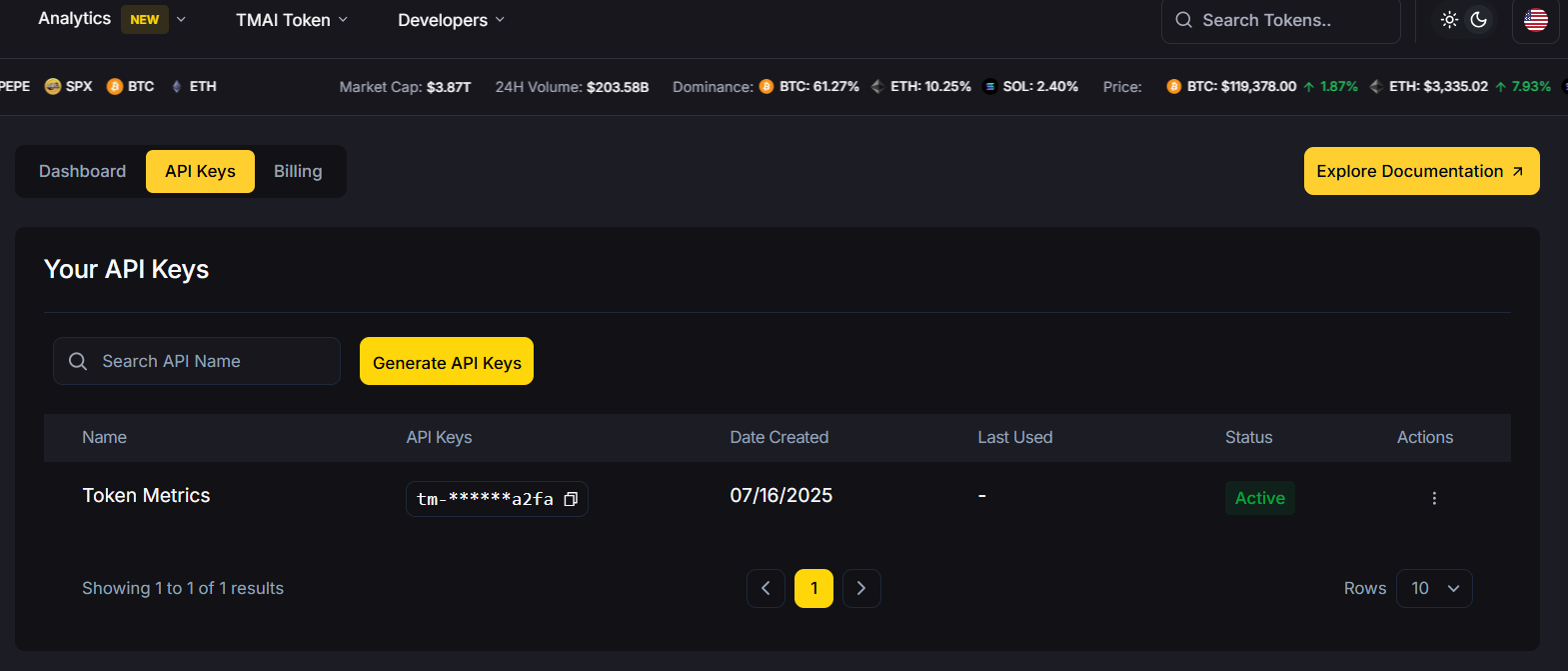
What’s inside the $TMAI API?
✅ AI-Powered Trading Signals – Bullish and bearish calls backed by over 80 data points
✅ Real-Time Grades – Instantly assess token momentum with Trader & Investor Grades
✅ Curated Indices – Plug into ready-to-use crypto portfolios by sector or market cap
✅ Lightning-Fast Performance – Built for bots, dashboards, dApps, and next-gen trading tools
Whether you’re building a DeFi dashboard, an alpha-sniping bot, or your own crypto terminal — this is your edge.
Price: Free
2. CoinMarketCap: CoinMarketCap offers one of the most popular APIs for retrieving real-time cryptocurrency market data, including prices, volume, and market capitalization for over 8,000 coins and tokens. It also offers endpoints for historical data and global averages.

Price Range: $0-$700 a month
3. CoinGecko: CoinGecko has an API that provides a comprehensive set of cryptocurrency data, including market data, developer activity, and community metrics for more than 10,000 coins and tokens. API is both paid and free, depending on your needs.

Price Range: Starting from $129 per month
4. CryptoCompare: CryptoCompare offers endpoints for news articles, social media activity, and mining data. It strives to find the best places to store, trade and mine cryptocurrencies.

Price Range: Free
5. BitMEX: BitMEX is a cryptocurrency derivatives exchange that provides access to real-time prices and historical data. Their API provides instant access to a variety of market data such as trading volumes and market caps.

Price & Plans: Custom
6. CoinDesk: CoinDesk is a platform for media, events, data and indices for the cryptocurrency market. CoinDesk Indices is a product of CoinDesk that offers access to cryptocurrency data with ease.
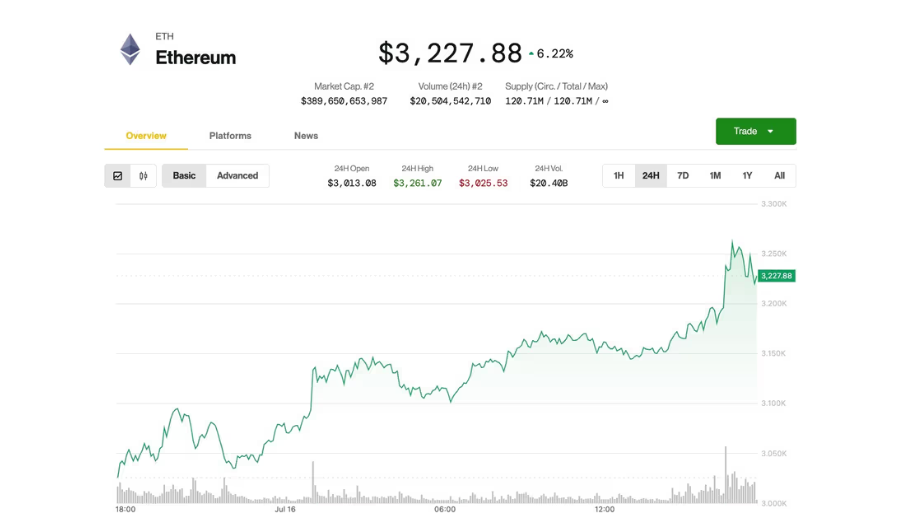
Price: Free
7. Bitstamp: Bitstamp is a cryptocurrency exchange that provides access to real-time prices and historical data. It provides premium access to crypto trading for both individuals and institutions through high liquidity, reliable order execution and constant uptime.

Price: 0.50% for those with under $10,000 in 30-day trading volume
8. CoinMarketCal: CoinMarketCal is a database of upcoming events related to cryptocurrencies, allowing you to track things like unlocks, giveaways, and more. Their API can be used to track your favourite coins.

Price: Free
9. Poloniex: Poloniex is a cryptocurrency exchange that provides access to real-time prices and historical data. The API also provides access to a variety of market data such as trading volumes and market caps.

Price: The Maker and Taker fee rates for trading USDT-collateralized perpetual contracts on Poloniex are 0.01% and 0.04% respectively, and the changes apply to all customers regardless of their trade volume.
10. Binance: Binance is one of the largest cryptocurrency exchanges and provides access to a variety of data such as prices, transactions, and blockchains. The API also allows developers to interact with the Binance platform, allowing them to buy, sell, and store cryptocurrencies.
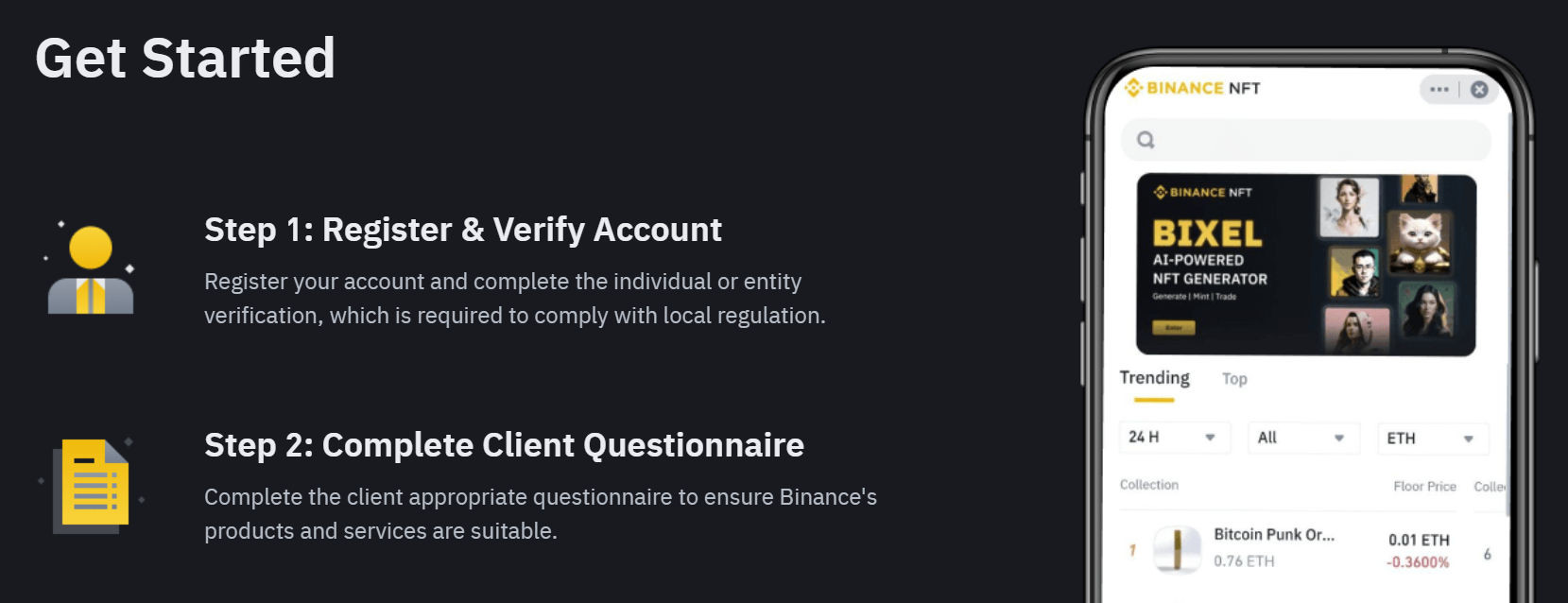
Price: Free
11. Kraken: Kraken is a cryptocurrency exchange and also provides access to crypto data such as prices, transactions, and blockchains. Like Binance, their API also allows you to interact with Kraken through code.
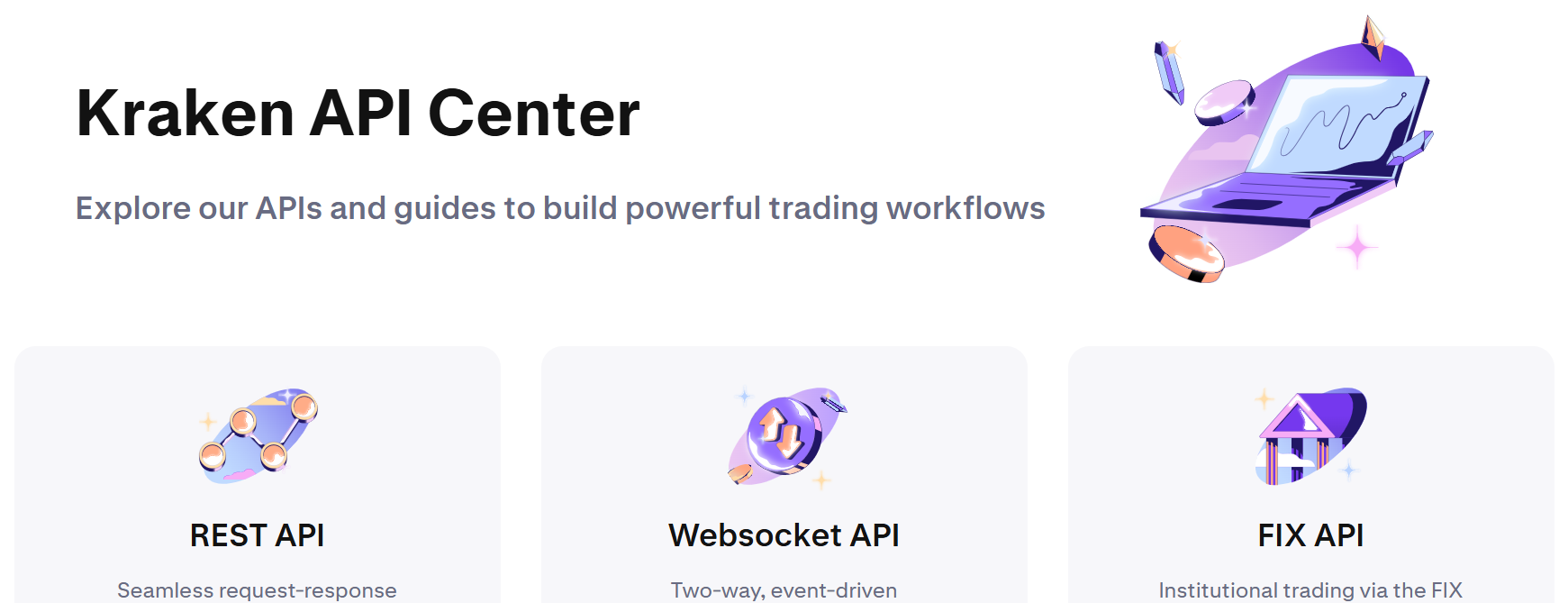
Price: 0.2-0.3% of the 30-day trade volume
12. CCXT: CCXT is a library for cryptocurrency trading and e-commerce with support for many bitcoin/ether/altcoin exchange markets and merchant APIs.
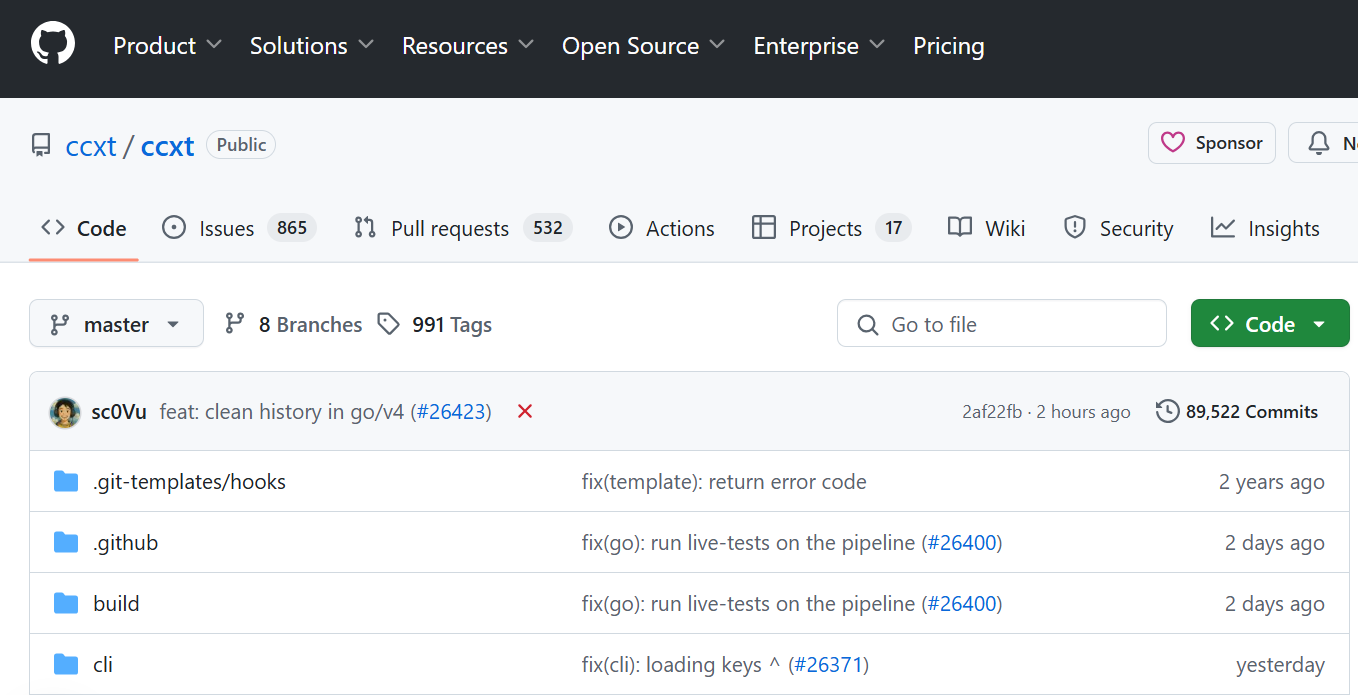
Price: $0-$29
Note: The prices are subject to change or may have already changed.
Choosing the best cryptocurrency API for your application can be a daunting task. There are a variety of APIs available, each with its own set of features and advantages. So, it’s important to take the time to research the different APIs and determine which one is right for your application.
When choosing a Cryptocurrency API, it’s important to consider the features it provides.
Here are a few questions you need answers to:
It’s also important to consider the pricing of the API. As mentioned above, some APIs are free, while others require a subscription fee. It’s important to consider the cost of the API and make sure it fits within your budget.
Using crypto APIs can be a great way to access data and create powerful applications. However, there are a few best practices to keep in mind when using these APIs.
To explore our FREE Token Metrics crypto API, click here.

%201.svg)
%201.svg)
Token Metrics is proud to launch the "TM Investor Grade" to help investors identify promising long-term investments in the world of cryptocurrency. The grade is comprised of three subsets:
Our statistical analysis and machine learning techniques help calculate these grades. They account for many data points to provide a strong indication of the relative strength of each crypto asset or a project.
The TM Investor Grade is intended for use by investors looking to hold onto investments for a longer period of time, created by combining the Fundamental Grade with the Technology Grade and Valuation Grade.
Fundamental analysis has always been a crucial part of the research process at Token Metrics. Before considering any potential long-term investments, we conduct a thorough fundamental analysis to understand an asset's underlying strengths and weaknesses. Our use of fundamental analysis is how we discovered the promising investment opportunity in Helium back in 2018.
However, manually performing fundamental analysis on every token in the market is not feasible. This is why our research and data science teams automated the process. The result is our Automated Long-term Investor Grade. This grade considers a wide range of data points and applies statistical analysis to provide scores in various categories, including valuation, investors, tokenomics, community, and more.
Token Metrics is also known for conducting code reviews on cryptocurrency projects. This is how we discovered that MATIC was a particularly strong project. Similar to fundamental analysis, our blockchain engineers carried out these reviews manually. However, we have now automated the entire process. Using open source data, we are able to provide technology scores for nearly all crypto assets. This is extremely valuable for investors, as it allows them to assess the long-term security and feasibility of different investments. Our technology scoring is based on three main categories: development activity, security and audit, and code quality.
The development activity category takes into account the contributions of the development community and tracks various community metrics. The security and audit category looks at the security of a project and tries to determine its resilience to hacks and other vulnerabilities. The code quality category measures how well the project's code is written, by evaluating the number of bugs and violations it has and how well it adheres to best coding practices and standards.
We are thrilled that our data science team, in collaboration with our engineering team, has been able to use statistical analysis to scale up our powerful technology scoring to cover almost all assets in the market.
The valuation grade compares a project's fully diluted value, or FDV, with the average FDV of different sectors that project belongs to.
Consider this example:
This will show a high valuation grade because the project is undervalued compared to its sectors.
By combining these grades, we get the TM Investor Grade which is much more powerful in determining the strength of the project in the long run.
To view the Investor Grade, you can go to the individual token details page. Click on the 'Investor' tab on the left of the screen, and then click on the 'Fundamentals' tab. Then, you will be able to see how the asset is performing in each of the 9 categories we use . All these categories are combined to create the overall Fundamental grade. To generate this grade, we use a wide variety of data sources to gather all the necessary information.

In the same tab, you will find the 'Technology' grade. This grade comprises many different data points. These data points combine into three major categories:
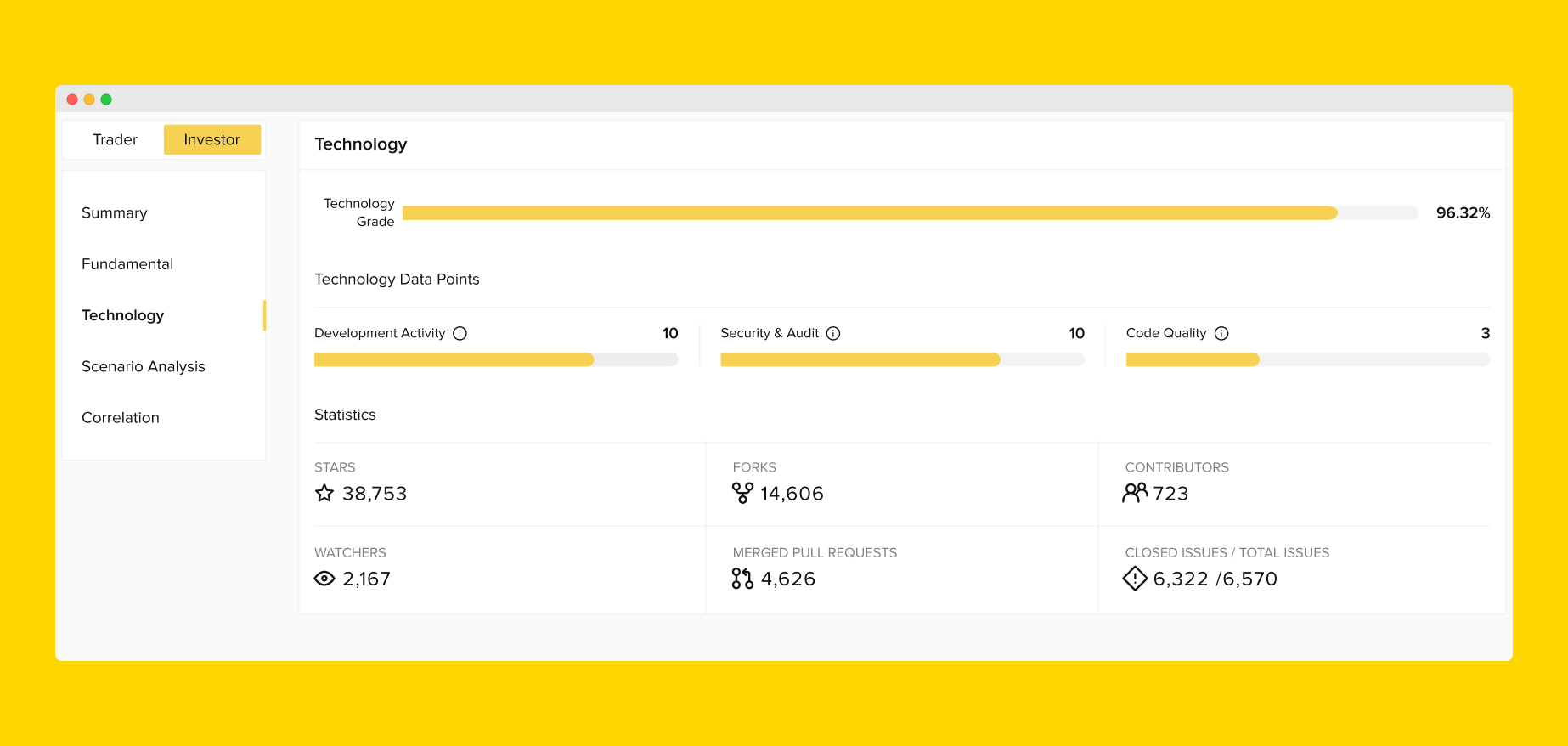
You can also access the newly-launched feature on the Rating page by pressing the Investor switch next to Trader. This will help you sort all crypto assets by our Long-term Investor Grade.

If you look at the Ratings page - sorted by Investor Grade in descending order [highest to lowest] - these are assets that Token Metrics believes have strong potential in the future.

The TM Investor Grade is a powerful tool for evaluating the long-term potential of cryptocurrency projects. By considering various data points, including fundamental analysis, technology scoring, and valuation grades, the grade provides a comprehensive assessment of a project's strengths and weaknesses.
The grade updates regularly to reflect changing market conditions, making it an essential tool for anyone looking to invest in the cryptocurrency space.
1. How does the Investor Grade differ from the Trader Grade?
The Investor Grade is intended for long-term investing, while the Trader Grade is geared toward short-term trading. The data points used to calculate the Investor Grade differ from those used for the Trader Grade.
2. Which grade should I pay more attention to - the Investor Grade or Trader Grade?
If you are interested in short-term trades based on price action, such as swing or day trades, you should consider the Trader Grade. On the other hand, the Investor Grade is more suitable for customers who want to invest long-term and hold on to their assets for the potential of significant returns or to discover undervalued assets.

%201.svg)
%201.svg)
As the world of cryptocurrency continues to evolve and the blockchain revolution continues to gain traction, non-fungible tokens (NFTs) are becoming increasingly popular. NFTs are digital assets that are stored on the blockchain and are unique and non-interchangeable. They are used to represent everything from art, music, videos, and digital collectibles. With the rise of NFTs, more and more people are looking for the best NFT marketplaces to buy and sell their NFTs. If you are someone who is also looking for the top NFT marketplaces to buy, sell, and trade NFTs on, this is the place to be.
In this article, we’ll take a look at what an NFT marketplace is and how they work. We’ll also provide a list of the best NFT marketplaces, so you can find the perfect place to buy or sell your digital artwork.
An NFT marketplace is a digital platform specifically designed to facilitate the sale and purchase of NFTs or Non-Fungible Tokens. NFTs are digital artworks that are created, bought, and sold on these marketplaces. They are unique digital tokens that are stored on the blockchain and can be bought, sold, and traded. It is the perfect place to find and purchase digital art works created by talented artists from around the world.
The concept of NFTs has been around for a few years, but it has only recently started to gain traction. As more people become aware of the potential of NFTs, the demand for these marketplaces is increasing. There are now many different NFT marketplaces available, each offering something unique and different.
NFT marketplaces are a great way to find and purchase unique digital artwork from talented artists. They are also a great way to invest in digital art, as NFTs can be bought, sold, and traded for a profit.
NFT marketplaces work by connecting buyers and sellers of digital artwork. Buyers can browse through the different artworks available, and then purchase the artwork they like. The artwork is stored on the blockchain, and the buyer receives a unique token that represents the artwork. This token can then be used to buy, sell, or trade the artwork.
When a buyer purchases an artwork, the money goes to the artist who created the artwork. The marketplace then takes a small commission for facilitating the transaction. The commission varies from marketplace to marketplace, but usually, it is around 5-10%.
The artwork is stored on the blockchain, and the buyer receives a unique token that represents the artwork. This token can then be used to buy, sell, or trade the artwork. The token can also be used as a form of digital currency and can be exchanged for other digital assets like cryptocurrencies.
NFT marketplaces are a great way to find, buy, and sell digital artwork. They are also a great way to invest in digital art, as NFTs can be bought, sold, and traded for a profit.
It is important to understand the best NFT marketplaces because they provide users with a secure, user-friendly platform to buy and sell NFTs. The marketplaces also provide users with access to a variety of services such as NFT auctions, NFT staking, NFT creation, and more.
The best NFT marketplaces also provide users with the option to purchase NFTs using cryptocurrency. This makes it easier for users to purchase NFTs without having to rely on traditional currency. The marketplaces also make it easy for users to store and manage their NFTs.
Finally, the NFT marketplaces also provide users with access to a wide variety of NFTs. This allows users to easily find and purchase the NFTs they are looking for.
The following is a list of the best NFT marketplaces for 2023. All of these marketplaces offer something unique and different and are great places to find and purchase digital artworks.
NFT marketplaces are a great way to find, buy, and sell digital artwork. They are also a great way to invest in digital art, as NFTs can be bought, sold, and traded for a profit.
Whether you’re looking to buy digital artwork or invest in digital art, these marketplaces are the perfect place to start. So why wait? Start exploring these marketplaces and find the perfect NFT for you today.

%201.svg)
%201.svg)
If you are wondering how to invest in the cryptocurrency space, this is the perfect place to be.
As the world of cryptocurrency continues to expand, it is important to understand what to consider before investing in cryptocurrency. This guide will provide you with a comprehensive overview of the most important things to consider before investing in cryptocurrency, including what to look for in a potential investment, alternative ways to buy a crypto, how to keep your cryptocurrency secure, and tips for investing responsibly.
Cryptocurrency investing can be an exciting and potentially profitable venture. But it's important to understand the risks associated with investing in cryptocurrency and the steps you should take before investing your hard-earned money. Cryptocurrency investing is a relatively new concept and the market is constantly evolving. It's important to do your research and understand the potential risks and rewards before jumping in.
In order to make an educated decision about whether or not cryptocurrency investing is right for you, you need to understand the basics of cryptocurrency investing. A cryptocurrency is a form of digital currency that is not controlled by any central authority, such as a government or bank. Instead, it is created and maintained by a decentralized network of computers that use cryptography to secure transactions. Cryptocurrency is typically exchanged for goods and services, or for other forms of currency.
There are a few key differences between cryptocurrency and traditional currencies. For one, cryptocurrency is not backed by any physical asset, such as gold or a government-issued currency. Additionally, cryptocurrency is not regulated by any government or financial institution. This means that the value of cryptocurrencies can be highly volatile and unpredictable, which can make investing in them a risky endeavor.
Before investing in cryptocurrency, it is important to understand the risks associated with it. Cryptocurrency is not backed by any physical asset, so its value is highly volatile and unpredictable. This means that investments can quickly lose value, and there is no guarantee that you will get your money back. Additionally, cryptocurrency is not regulated by any government or financial institution, so it can be difficult to know who to trust and who to avoid.
When considering whether or not to invest in cryptocurrency, it's important to understand the different types of cryptocurrencies available. There are thousands of different cryptocurrencies on the market, each with its own set of characteristics and features. It's important to research each type of cryptocurrency and determine which one might be the best fit for your investment goals.
You should also consider the cost of investing in cryptocurrency. Cryptocurrency is a global market, so the cost of investing in it can vary significantly from one country to the next. Additionally, different exchanges may charge different fees for trading. It's important to research the fees associated with each exchange to ensure you are getting the best deal.
Finally, it's important to understand the potential tax implications of investing in cryptocurrency. Many countries have different regulations regarding the taxation of cryptocurrency investments, so it is important to understand the rules in your area before investing.
When it comes to investing in cryptocurrency, there are a few different ways to go about it. The most popular way to purchase cryptocurrency is through an online exchange. These exchanges are typically easy to use and offer a variety of different cryptocurrencies. Additionally, some exchanges offer lower fees than others, so it's important to shop around for the best deal.
Another option for investing in cryptocurrency is to purchase it directly from an individual. This can be done through a peer-to-peer platform, such as LocalBitcoins. This allows you to purchase cryptocurrency directly from another individual, without having to go through an exchange. However, this method can be riskier than using an exchange, as there is no guarantee that the person you are purchasing from is legitimate.
Finally, there are some platforms that allow you to purchase cryptocurrency with a credit or debit card. This is typically the easiest and most convenient way to purchase cryptocurrency, but it also has some drawbacks. Credit and debit card purchases typically come with higher fees than other methods, and the transactions can be reversed if the seller does not deliver the cryptocurrency as promised.
Follow this 5-step process to make first cryptocurrency investment.
If you are new to crypto, you can start off by choosing a broker or a crypto exchange. Although both serve the same purpose, there is a tiny difference between them.
Cryptocurrency Exchange is a third-party company that can help you invest in crypto with a convenience fee. Both buyers and sellers can actively trade cryptocurrencies using the platform. Having said that, make sure to learn enough about the standard crypto trading platforms before investing.
Once you are set with the platform, now you have to simply create an account and then authenticate yourself to start hassle free trading.
Now that you have verified your account, it is time to add your bank account or use a debit card to ensure cash deposit to invest in crypto.
Yes! You are almost there. You just need to take one more step of placing your cryptocurrency order to start your trade. You can enter the ticker symbols, such as BTC for Bitcoin, and invest as you please.
Since cryptocurrency exchanges are not regulated or secured widely, it is essential that you choose an appropriate storage method to avoid the risk of theft or hacking. It is best to store cryptocurrencies offline or in a cold wallet like Ledger.
Once you have purchased your cryptocurrency, it is important to take steps to keep it secure. The first step is to create a secure wallet to store your cryptocurrency. There are a variety of different wallets available, so you should research each one and determine which one is best for your needs.
Once you have chosen a wallet, it is important to create a strong password and keep it safe. This password should be unique and difficult to guess. Additionally, you should enable two-factor authentication whenever possible. This will require a second form of verification, such as a code sent to your phone, before you can access your wallet.
It is also important to keep your wallet backed up. Many wallets offer the ability to export your funds to a secure backup. This will ensure that you can recover your funds if something were to happen to your wallet. You should also keep your wallet updated with the latest security patches to help ensure that your funds are safe.
Cryptocurrency investing can be an exciting and potentially lucrative venture, but it's important to invest responsibly. Before investing, it's important to understand the risks associated with cryptocurrency investing, such as the potential for highly volatile prices. Additionally, it's important to understand the tax implications of investing in cryptocurrency and ensure that you are following all applicable laws.
It's also important to diversify your investments. Rather than investing all your money into a single cryptocurrency, it's wise to spread your investments across a variety of different coins and tokens. This will help to reduce your risk and ensure that you are diversifying your portfolio.
Finally, it's important to invest only what you can afford to lose. The cryptocurrency market is highly unpredictable, so there is always the potential for losses. It's important to remember that investing in cryptocurrency is a long-term process and that short-term gains should not be your primary focus.
As an investor, you need an acute understanding of what could be the potential cryptocurrencies that make you good fortune. And for that, you need to dig deeper into analyzing hundreds of coins to know and understand the best investments to make.
We help with that. Token Metrics is an AI-based crypto-research platform that can save you hours of research and bring you accurate data to make an informed decision.
Click here to get ahold of the BEST plans available for crypto investors like you.
Cryptocurrency investing can be an exciting and potentially profitable venture, but it's important to understand the risks and rewards before investing your hard-earned money. This guide has provided you with a comprehensive overview of the most important things to consider before investing in cryptocurrency, including what to look for in a potential investment, alternative ways to buy cryptocurrency, how to keep your cryptocurrency secure, and tips for investing responsibly. With the right knowledge and strategies, you can invest in cryptocurrency with confidence and reap the rewards of a successful investment.


 Create Your Free Account
Create Your Free Account9450 SW Gemini Dr
PMB 59348
Beaverton, Oregon 97008-7105 US
.svg)




.png)
Token Metrics Media LLC is a regular publication of information, analysis, and commentary focused especially on blockchain technology and business, cryptocurrency, blockchain-based tokens, market trends, and trading strategies.
Token Metrics Media LLC does not provide individually tailored investment advice and does not take a subscriber’s or anyone’s personal circumstances into consideration when discussing investments; nor is Token Metrics Advisers LLC registered as an investment adviser or broker-dealer in any jurisdiction.
Information contained herein is not an offer or solicitation to buy, hold, or sell any security. The Token Metrics team has advised and invested in many blockchain companies. A complete list of their advisory roles and current holdings can be viewed here: https://tokenmetrics.com/disclosures.html/
Token Metrics Media LLC relies on information from various sources believed to be reliable, including clients and third parties, but cannot guarantee the accuracy and completeness of that information. Additionally, Token Metrics Media LLC does not provide tax advice, and investors are encouraged to consult with their personal tax advisors.
All investing involves risk, including the possible loss of money you invest, and past performance does not guarantee future performance. Ratings and price predictions are provided for informational and illustrative purposes, and may not reflect actual future performance.

